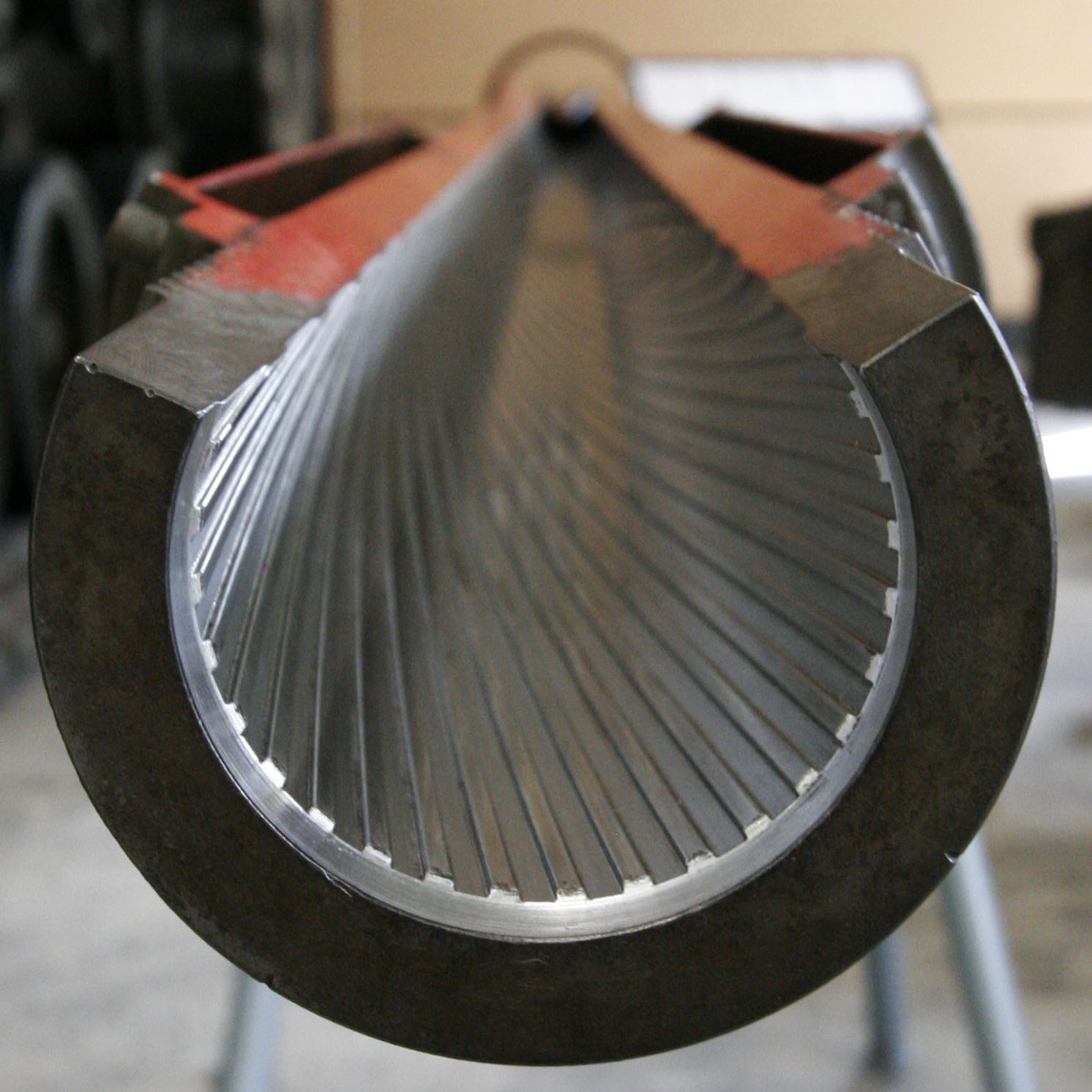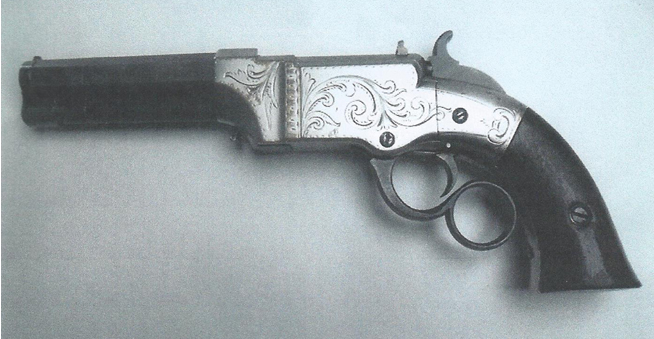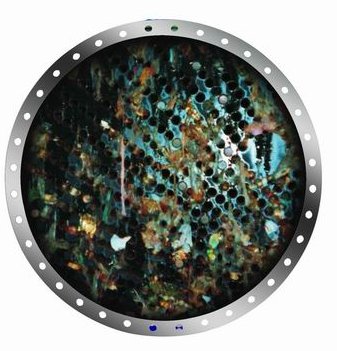|
Breech-loading
A breechloader is a firearm in which the user loads the ammunition from the breech end of the barrel (i.e., from the rearward, open end of the gun's barrel), as opposed to a muzzleloader, in which the user loads the ammunition from the ( muzzle) end of the barrel. The vast majority of modern firearms are generally breech-loaders, while firearms made before the mid-19th century were mostly smoothbore muzzle-loaders. Only a few muzzleloading weapons, such as mortars, rifle grenades, some rocket launchers, such as the Panzerfaust 3 and RPG-7, and the GP series grenade launchers, have remained in common usage in modern military conflicts. However, referring to a weapon explicitly as breech-loading is mostly limited to weapons where the operator loads ammunition by hand (and not by operating a mechanism such as a bolt-action), such as artillery pieces or break-action small arms. Breech-loading provides the advantage of reduced reloading time because it is far quicker to load ... [...More Info...] [...Related Items...] OR: [Wikipedia] [Google] [Baidu] |
Artillery
Artillery consists of ranged weapons that launch Ammunition, munitions far beyond the range and power of infantry firearms. Early artillery development focused on the ability to breach defensive walls and fortifications during sieges, and led to heavy, fairly immobile siege engines. As technology improved, lighter, more mobile field artillery cannons were developed for battlefield use. This development continues today; modern self-propelled artillery vehicles are highly mobile weapons of great versatility generally providing the largest share of an army's total firepower. Originally, the word "artillery" referred to any group of soldiers primarily armed with some form of manufactured weapon or armour. Since the introduction of gunpowder and cannon, "artillery" has largely meant cannon, and in contemporary usage, usually refers to Shell (projectile), shell-firing Field gun, guns, howitzers, and Mortar (weapon), mortars (collectively called ''barrel artillery'', ''cannon artil ... [...More Info...] [...Related Items...] OR: [Wikipedia] [Google] [Baidu] |
Cannon
A cannon is a large-caliber gun classified as a type of artillery, which usually launches a projectile using explosive chemical propellant. Gunpowder ("black powder") was the primary propellant before the invention of smokeless powder during the late 19th century. Cannons vary in gauge (firearms), gauge, effective range, mobility (military), mobility, rate of fire, elevation (ballistics), angle of fire and firepower; different forms of cannon combine and balance these attributes in varying degrees, depending on their intended use on the battlefield. A cannon is a type of heavy artillery weapon. The word ''cannon'' is derived from several languages, in which the original definition can usually be translated as ''tube'', ''cane'', or ''reed''. The earliest known depiction of cannons may have appeared in Science and technology of the Song dynasty#Gunpowder warfare, Song dynasty China as early as the 12th century; however, solid archaeological and documentary evidence of cannons do ... [...More Info...] [...Related Items...] OR: [Wikipedia] [Google] [Baidu] |
Bolt-action
Bolt action is a type of manual Action (firearms), firearm action that is operated by ''directly'' manipulating the bolt (firearms), turn-bolt via a cocking handle, bolt handle, most commonly placed on the right-hand side of the firearm (as most users are right-handed). The majority of bolt-action firearms are rifles, but there are also some variants of shotguns and handguns that are bolt-action. Bolt action firearms are generally repeating firearms, but many single-shot designs are available particularly in shooting sports where single-shot firearms are mandated, such as most Olympic and International Shooting Sport Federation, ISSF rifle disciplines. From the late 19th century all the way through both World Wars, bolt action rifles were the standard infantry service rifle, service weapons for most of the world's military forces, with the exception of the United States Armed Forces, who used the M1 Garand Semi-automatic rifle. In modern military and law enforcement after ... [...More Info...] [...Related Items...] OR: [Wikipedia] [Google] [Baidu] |
Gun Barrel
A gun barrel is a crucial part of gun-type weapons such as small arms, small firearms, artillery pieces, and air guns. It is the straight shooting tube, usually made of rigid high-strength metal, through which a contained rapid expansion of high-pressure gas(es) is used to propel a projectile out of the front end (muzzle (firearms), muzzle) at a high velocity. The hollow interior of the barrel is called the bore, and the diameter of the bore is called its calibre, usually measured in inches or millimetres. The first firearms were made at a time when metallurgy was not advanced enough to cast tubes capable of withstanding the explosive forces of early cannons, so the pipe (often built from staves of metal) needed to be braced periodically along its length for structural reinforcement, producing an appearance somewhat reminiscent of storage barrels being stacked together, hence the English name. History Gun barrels are usually made of some type of metal or Alloy, metal alloy. ... [...More Info...] [...Related Items...] OR: [Wikipedia] [Google] [Baidu] |
Muzzle (firearms)
A gun barrel is a crucial part of gun-type weapons such as small firearms, artillery pieces, and air guns. It is the straight shooting tube, usually made of rigid high-strength metal, through which a contained rapid expansion of high-pressure gas(es) is used to propel a projectile out of the front end ( muzzle) at a high velocity. The hollow interior of the barrel is called the bore, and the diameter of the bore is called its calibre, usually measured in inches or millimetres. The first firearms were made at a time when metallurgy was not advanced enough to cast tubes capable of withstanding the explosive forces of early cannons, so the pipe (often built from staves of metal) needed to be braced periodically along its length for structural reinforcement, producing an appearance somewhat reminiscent of storage barrels being stacked together, hence the English name. History Gun barrels are usually made of some type of metal or metal alloy. However, during the late Tang ... [...More Info...] [...Related Items...] OR: [Wikipedia] [Google] [Baidu] |
Rifling
Rifling is the term for helical grooves machined into the internal surface of a firearms's barrel for imparting a spin to a projectile to improve its aerodynamic stability and accuracy. It is also the term (as a verb) for creating such grooves. The opposite of rifling is smoothbore. Rifling is measured in ''twist rate'', the distance the rifling takes to complete one full revolution, expressed as a ratio with 1 as its base (e.g., 1:). A shorter distance/lower ratio indicates a faster twist, generating a higher spin rate (and greater projectile stability). The combination of length, weight, and shape of a projectile determines the twist rate needed to gyroscopically stabilize it: barrels intended for short, large-diameter projectiles such as spherical lead balls require a very low twist rate, such as 1 turn in 48 inches (122 cm). Barrels intended for long, small-diameter projectiles, such as the ultra-low-drag 80-grain 0.223 inch bullets (5.2 g, 5.56&nb ... [...More Info...] [...Related Items...] OR: [Wikipedia] [Google] [Baidu] |
Muzzleloader
A muzzleloader is any firearm in which the user loads the bullet, projectile and the propellant charge into the Muzzle (firearms), muzzle end of the gun (i.e., from the forward, open end of the gun's barrel). This is distinct from the modern designs of Breechloader, breech-loading firearms, in which user loads the ammunition into the Chamber (firearms), breech end of the gun barrel, barrel. The term "muzzleloader" applies to both rifled and smoothbore type muzzleloaders, and may also refer to the marksman who specializes in the shooting of such firearms. The firing methods, paraphernalia and mechanism further divide both categories as do caliber (from cannons to small-caliber palm guns). Modern muzzleloading firearms range from reproductions of sidelock, flintlock and percussion cap, percussion long guns, to in-line rifles that use modern inventions such as a closed breech, sealed percussion cap, primer and fast rifling to allow for considerable accuracy at long ranges. Modern Mo ... [...More Info...] [...Related Items...] OR: [Wikipedia] [Google] [Baidu] |
Repeating Firearm
A repeating firearm or repeater is any firearm (either a handgun or long gun) that is designed for multiple, repeated firings before the gun has to be reloaded with new ammunition. Unlike single-shot firearms, which can only hold and fire a single round of ammunition, a repeating firearm can store multiple cartridge (firearms), cartridges inside a magazine (firearms), magazine (as in pistols, rifles, or shotguns), a cylinder (firearms), cylinder (as in revolvers), or a belt (firearms), belt (as in machine guns), and uses a moving action (firearms), action to manipulate each cartridge into and out of the battery position (within the chamber (firearms), chamber and in alignment with the gun barrel#Bore, bore). This allows the weapon to be discharged repeatedly in relatively quick succession, before manually reloading the ammunition is needed. Typically the term "repeaters" refers to the more ubiquitous single-gun barrel, barreled variants. Multiple-barrel firearms such as derringe ... [...More Info...] [...Related Items...] OR: [Wikipedia] [Google] [Baidu] |
Gun Turret
A gun turret (or simply turret) is a mounting platform from which weapons can be fired that affords protection, visibility and ability to turn and aim. A modern gun turret is generally a rotatable weapon mount that houses the crew or mechanism of a projectile-firing weapon and at the same time lets the weapon be aimed and fired in some degree of azimuth and elevation (cone of fire). Description Rotating gun turrets protect the weapon and its crew as they rotate. When this meaning of the word "turret" started being used at the beginning of the 1860s, turrets were normally cylindrical. Barbettes were an alternative to turrets; with a barbette the protection was fixed, and the weapon and crew were on a rotating platform inside the barbette. In the 1890s, armoured hoods (also known as "gun houses") were added to barbettes; these rotated with the platform (hence the term "hooded barbette"). By the early 20th century, these hoods were known as turrets. Modern warships have gun-m ... [...More Info...] [...Related Items...] OR: [Wikipedia] [Google] [Baidu] |
Break-action
Break action is a type of firearm action in which the barrel(s) are hinged much like a door and rotate perpendicularly to the bore axis to expose the breech and allow loading and unloading of cartridges. A separate operation may be required for the cocking of a hammer to fire the new round. There are many types of break-action firearms; break actions are universal in double-barreled shotguns, double-barreled rifles, combination guns, and are commonly found in single shot pistols (especially derringers), rifles, shotguns, including flare guns, grenade launchers, air guns, and some older revolver designs. They are also known as hinge-action, break-open, break-barrel, break-top, or, on old revolvers, top-break actions. Description Break action The first break-action revolver was patented in France and Britain at the end of December in 1858 by Devisme. A substantial hinge pin joins the two parts of the rifle or shotgun; the stock with its firing mechanism and the fore-piece ... [...More Info...] [...Related Items...] OR: [Wikipedia] [Google] [Baidu] |
GP-25
The GP-25 ''Kostyor'' ("Bonfire"), GP-30 ''Obuvka'' ("Shoe") and GP-34 are a family of Russian 40 mm under-barrel muzzleloaded grenade launchers for the AK family of assault rifles. The acronym GP stands for ''Granatomyot Podstvolnyj'', "under-barrel grenade launcher" in Russian, and was adopted by Soviet forces in 1978. Development The development of a grenade launcher for the AKM assault rifle began in 1966 at the Central Design and Research Bureau of Sporting and Hunting Arms (TsKIB SOO). Development continued into the 1970s, and in 1978 it was accepted into service. The main production version was known as the GP-25, and could be attached to the AKM and AK-74 assault rifles. The GP-30 was made lighter and the aiming system was redesigned and moved to the right. GP grenade launchers are similar in appearance and fire the same Russian 40mm caliber ammunition. At the top of the barrel is the mounting hardware to attach the weapon to the underside of a rifle barrel, fr ... [...More Info...] [...Related Items...] OR: [Wikipedia] [Google] [Baidu] |
Fouling
Fouling is the accumulation of unwanted material on solid surfaces. The fouling materials can consist of either living organisms (biofouling, organic) or a non-living substance (inorganic). Fouling is usually distinguished from other surface-growth phenomena in that it occurs on a surface of a component, system, or plant performing a defined and useful function and that the fouling process impedes or interferes with this function. Other terms used in the literature to describe fouling include deposit formation, encrustation, crudding, deposition, scaling, scale formation, slagging, and sludge formation. The last six terms have a more narrow meaning than fouling within the scope of the fouling science and technology, and they also have meanings outside of this scope; therefore, they should be used with caution. Fouling phenomena are common and diverse, ranging from fouling of ship hulls, natural surfaces in the marine environment (fouling community, marine fouling), fouling ... [...More Info...] [...Related Items...] OR: [Wikipedia] [Google] [Baidu] |









